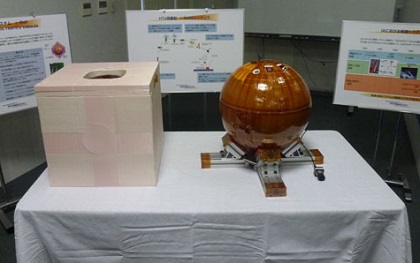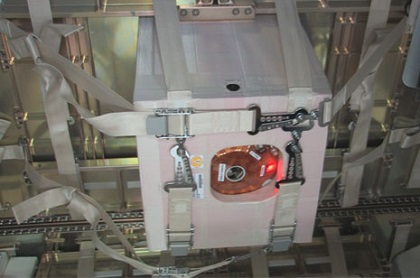This is an archive of information released in the past.
Disclaimer: It may contain broken links or outdated information. Some parts may not function in current web browsers.
*Visit https://humans-in-space.jaxa.jp/en/ for the latest information.

Experiment
- News
- Kibo Utilization Strategy
- Kibo Utilization Plan
- List of JAXA's Utilization Themes
- Experiment Facilities
- Space Environment Utilization
- Archive
Re-entry Data Recorder (i-Ball)

i-Ball (Credit: JAXA)
The Japanese Re-entry Data Recorder "i-Ball" is a globular-shaped data recorder whose purpose is to obtain various re-entry data and photo images while its re-entry. Loaded into a supply vehicle shortly before its leave from the ISS, i-Ball enters into atomosphere aboard the vehicle and obtains various kinds of data while its re-entry and send the data to ground via an iridium satellite.
While the vehicle is burnt up after the re-entery, i-Ball endures high temperature and falls down with parachute and splashdowns on the ocean and keeps sending data. Although i-Ball stays afloat for a while for data transmission, it will eventually sink in the water and will not be recovered.
i-Ball was developed under the cooperation between JAXA and private sector and was first loaded in the H-II Transfer Vehicle KOUNOTORI3 (HTV3 mission) in 2012. Analyzing the data sent from i-Ball will lead to an identification of breakup phenomenon of re-entering vehicles and decrease of the reentry debris risks. In addition, it will help to obtain design data for future vehicles.
| Name | Re-entry Data Recorder "i-Ball" | |
| Developer | IHI AEROSPACE Co.,Ltd. | |
| Obtainable data |
|
|
| Total Mass | 15.5 kg (17kg, including cover) | |
| Diameter | Outside diameter Φ400mm (410×440×435mm including cover) | |
| Landing system | Splashdown after decelerated by a parachute opening | |

i-Ball strapped to waste cargo (HTV3) (Credit: JAXA/NASA)

Re-entry photo data sent from i-Ball (HTV3)(Credit: JAXA)
| Copyright 2007 Japan Aerospace Exploration Agency | Site Policy |